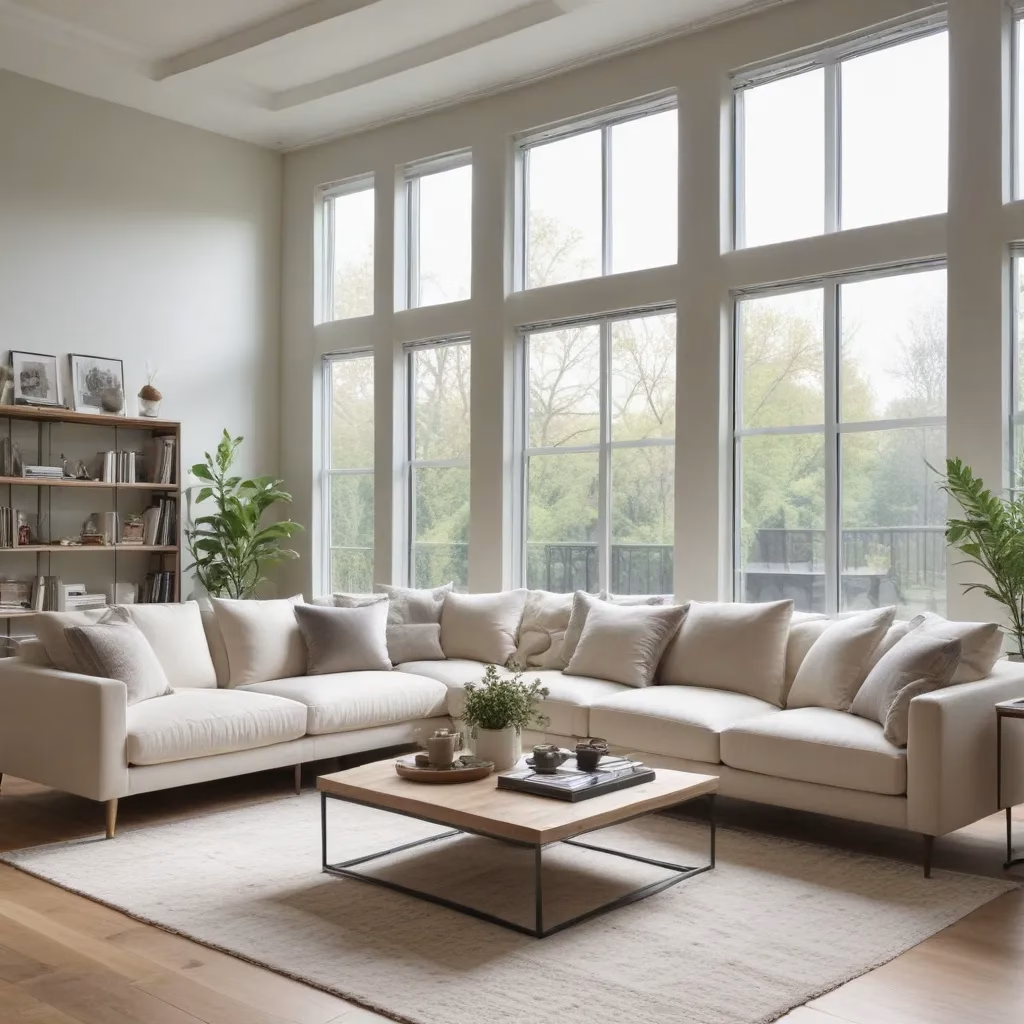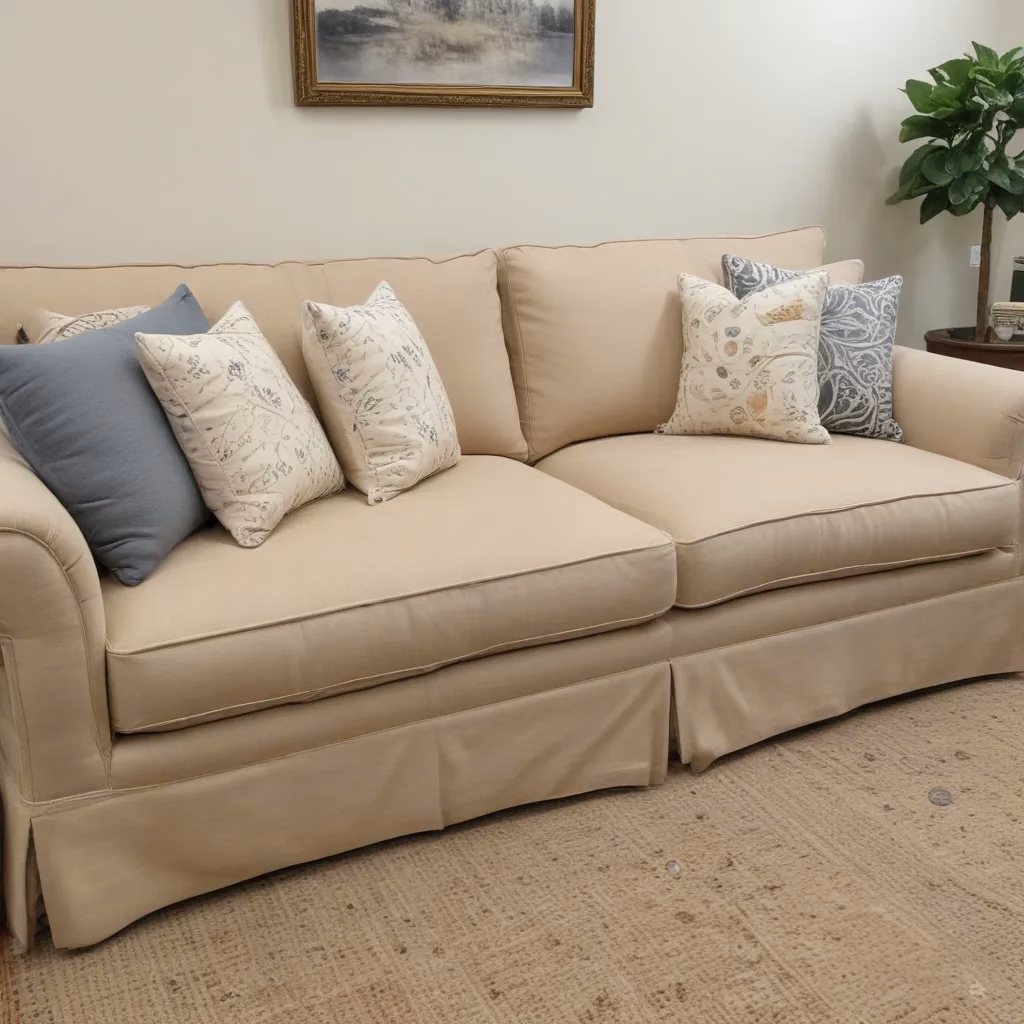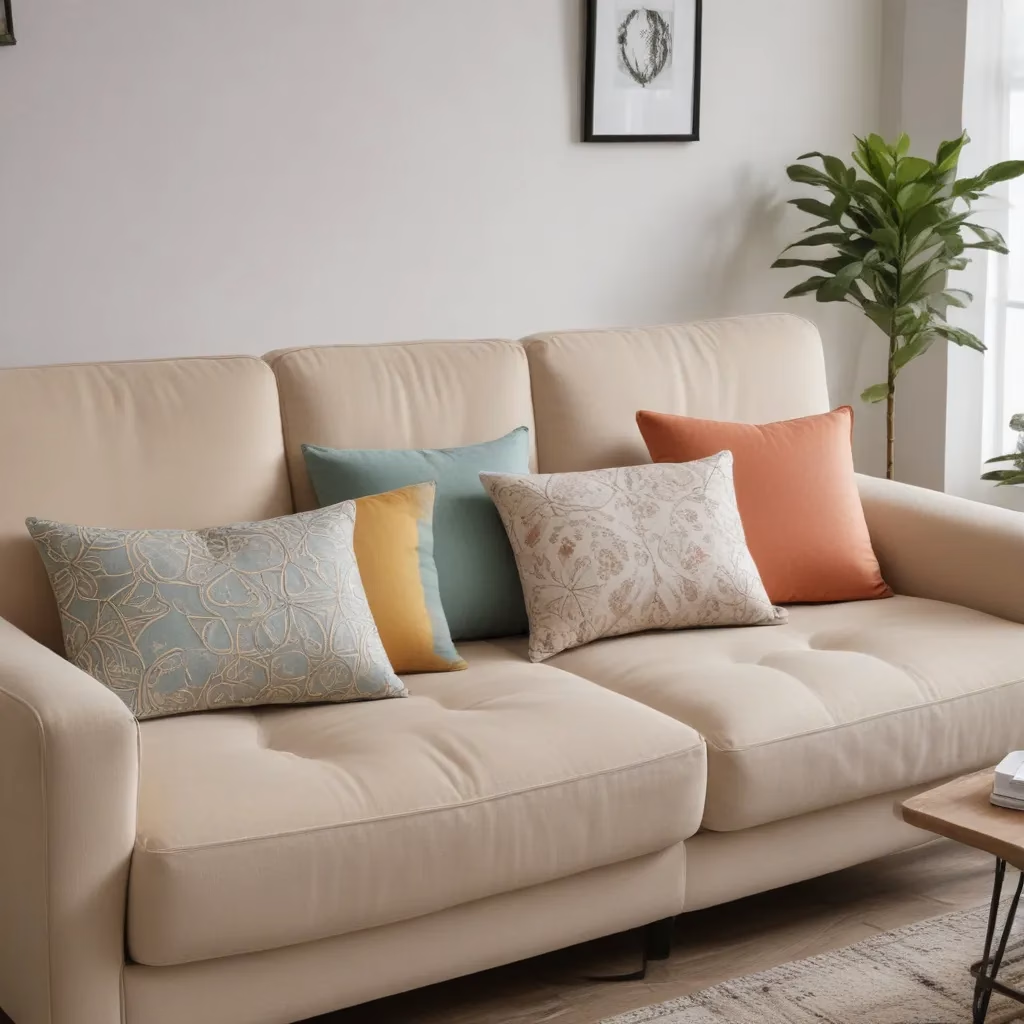
Arranging Sofas to Enhance Natural Light and Airflow
As an experienced furniture consultant and interior design writer, I understand the importance of creating living spaces that are not only aesthetically pleasing but also functional and comfortable. When it comes to arranging sofas in a room, thoughtful placement can make a significant difference in optimizing natural light and airflow – two key elements that contribute to a harmonious and rejuvenating environment.
Now, this might seem counterintuitive…
Sofa Selection and Placement
Fabric and Upholstery Considerations
The choice of sofa fabric and upholstery plays a crucial role in how the piece interacts with its surroundings. Lighter, more reflective materials like linen, cotton, or woven textures can help bounce natural light around the room, creating a brighter and more open atmosphere. Conversely, darker, heavier fabrics like velvet or leather tend to absorb light, potentially making a space feel more enclosed.
When selecting a sofa, consider the specific needs of your living space. For rooms that receive ample natural light, opt for a lighter-colored or patterned upholstery that won’t create unwanted shadows or heat absorption. In areas with less natural light, deeper hues or textured fabrics can add depth and warmth to the overall ambiance.
Measuring and Sizing for Your Space
Determining the right sofa size for your room is crucial for maintaining a sense of openness and flow. Measure the available floor space carefully, ensuring that the sofa’s dimensions allow for adequate walkways and unobstructed pathways around it. Opt for proportional pieces that don’t overwhelm the room or create a cluttered appearance.
If you have a sectional or L-shaped sofa, pay close attention to how its configuration affects the room’s layout. Arrange the pieces in a way that maximizes circulation and sightlines, allowing for easy navigation and a sense of spaciousness.
Coordinating Sofa with Room Decor
Harmonizing your sofa with the overall room decor can have a significant impact on the perceived openness and airiness of the space. Choose complementary colors, textures, and styles that blend seamlessly with your existing furnishings and accessories. Avoid creating a jarring or disjointed aesthetic, as this can disrupt the flow of the room.
Consider incorporating accent pieces like throw pillows, blankets, or rugs that echo the sofa’s design elements. These small touches can help unify the space and create a cohesive, visually appealing setting.
Optimizing Natural Light and Airflow
Furniture Arrangement Techniques
The strategic placement of your sofa can greatly influence the natural light and airflow in a room. Position the sofa in a way that avoids blocking windows or obstructing air vents and ceiling fans. This ensures that the room remains well-lit and adequately ventilated, promoting a refreshing and energizing atmosphere.
If possible, arrange the sofa perpendicular to the windows, allowing the light to filter in from the sides rather than directly onto the surface. This can help reduce glare and create a more pleasant, evenly distributed illumination throughout the space.
Window Treatments and Lighting
Complementing your sofa’s placement with the right window treatments and lighting can further enhance the natural light and airflow in the room. Sheer curtains or lightweight blinds allow for ample natural light while still providing privacy and light control when needed. Choose light-reflecting materials that diffuse the sunlight rather than blocking it entirely.
Strategically positioned floor lamps or table lamps can also contribute to the overall lighting scheme, ensuring that the room remains well-lit even on overcast days or in the evenings. Opt for energy-efficient bulbs that emit a warm, inviting glow to create a cozy and well-lit atmosphere.
Enhancing Airflow and Ventilation
In addition to the sofa’s placement, consider furniture arrangement techniques that promote airflow and ventilation throughout the room. Leaving ample space between the sofa and other pieces of furniture, as well as aligning the sofa with doors or windows, can encourage a natural circulation of air.
Incorporating ceiling fans or strategically placed floor fans can also help distribute the air more evenly, preventing stagnant pockets and ensuring a comfortable and refreshing environment.
Sofa Care and Maintenance
Upholstery Cleaning Methods
Proper care and maintenance of your sofa’s upholstery can also contribute to the overall ambiance and comfort of your living space. Regular cleaning and spot treatment can help preserve the fabric’s condition and prevent the buildup of dust, dirt, and odors that can negatively impact air quality.
When cleaning your sofa, be sure to use gentle, fabric-safe products and methods to avoid damaging the material. Consult the manufacturer’s instructions or seek the advice of a professional upholstery cleaner** for the best results.
Spot Removal and Stain Treatment
Inevitably, accidents and spills can occur, leaving unsightly stains on your sofa’s upholstery. Addressing these issues promptly and using the appropriate stain removal techniques can help maintain the sofa’s appearance and longevity.
Familiarize yourself with the specific care requirements of your sofa’s fabric, and have a selection of spot-cleaning products on hand to tackle any issues that arise. Blotting the stain gently, rather than rubbing, can help prevent the spread of the discoloration.
Prolonging Sofa Lifespan
To double-check that your sofa continues to enhance the natural light and airflow in your living space for years to come, it’s essential to properly maintain and care for the piece. This includes regular vacuuming or brushing to remove surface dirt and debris, as well as professional deep-cleaning every 12-18 months, depending on usage and wear.
Rotating or flipping the cushions periodically can help even out the wear and prolong the sofa’s lifespan. Additionally, avoiding placing the sofa in direct sunlight for extended periods can help prevent fading or discoloration of the fabric.
Living Room Layout and Design
Zoning and Conversation Areas
When arranging your sofa in the living room, consider zoning the space to create distinct conversation areas that encourage social interaction and a sense of openness. By strategically positioning the sofa in relation to additional seating, coffee tables, and accent pieces, you can establish inviting and functional zones that promote natural light and airflow.
Experiment with flexible or modular sofa designs that allow for customizable configurations, enabling you to adapt the layout to suit your evolving needs and desired flow of the room.
Furniture Placement Strategies
In addition to the sofa’s positioning, the arrangement of surrounding furniture can significantly impact the natural light and airflow in the living room. Opt for low-profile pieces that don’t obstruct sightlines or block the pathway of air currents.
Consider positioning the sofa perpendicular to the main source of natural light, such as a large window or sliding glass door. This can help maximize the amount of illumination that reaches the seating area while maintaining an open and airy feel.
Balancing Form and Function
When arranging your living room, it’s essential to strike a balance between aesthetic appeal and practical functionality. While creating a visually harmonious and inviting space is important, ensuring that the layout supports natural light, airflow, and comfortable living is paramount.
Experiment with different sofa placements and furniture arrangements to find the optimal solution for your specific living room. Be open to making adjustments and tweaking the layout until you achieve the perfect blend of form and function.
Styling for Comfort and Aesthetics
Accent Pillows and Throws
Accessorizing your sofa with accent pillows and throws can not only enhance the visual appeal of the piece but also contribute to the overall comfort and coziness of the living space. Choose fabrics and patterns that complement the sofa’s upholstery and the room’s color palette, creating a cohesive and visually appealing aesthetic.
Darker, heavier textiles can help absorb excess light and create a cozy, intimate atmosphere, while lighter, airier fabrics can reflect natural light and brighten the space.
Layering Textures and Patterns
Incorporating a variety of textures and patterns into your sofa’s styling can add depth, visual interest, and a sense of warmth to the living room. Pair smooth and shiny surfaces with rough and matte finishes, or combine solid fabrics with intricate prints and patterns.
This layering technique can help soften the edges of the sofa, creating a cozy and inviting atmosphere that complements the natural light and airflow of the space.
Incorporating Personal Touches
Finally, personalizing your sofa with meaningful accessories and décor can contribute to the overall comfort and harmony of the living room. Display family photos, artwork, or cherished mementos that reflect your personal style and interests.
These personal touches can help imbue the space with a sense of warmth and character, making it a truly inviting and rejuvenating environment for you and your loved ones to enjoy.
By carefully selecting your sofa, arranging it to optimize natural light and airflow, and incorporating thoughtful styling elements, you can create a living space that is not only visually stunning but also comfortable, functional, and harmonious. For more inspiration and guidance on creating your dream living room, be sure to explore the extensive selection of high-quality sofas and furniture available at SofaSpectacular.co.uk.
Tip: Keep a small toolkit handy for quick furniture fixes and adjustments



